Papers by Deanna Rothwell
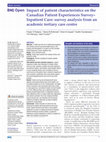
BMJ Open, 2018
ObjectiveTo determine the role of patient demographics, care domains and self-perceived health st... more ObjectiveTo determine the role of patient demographics, care domains and self-perceived health status in the analysis and interpretation of results from the Canadian Patient Experience Survey–Inpatient Care.DesignCross-sectional survey.SettingSingle large Canadian two campus tertiary care academic centre.ParticipantsRandom sampling of hospital patients postdischarge.Intervention and main outcome measuresLogistic regression models were developed to analyse topbox scoring on four questions of global care (rate experience, recommend hospital, rate hospital, overall helped). Means of each composite domain were correlated to the four overall scores at the patient level to determine Spearman’s rank correlation coefficients which were plotted against the overall (hospital) domain score for the key driver analysis.ResultsTopbox scoring was decreased with worse degrees of perceived physical and mental health in all four global questions (p<0.05). Female gender and higher levels of educati...
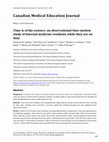
The effects of changes to resident physician duty hours need to be measureable. This time-motion ... more The effects of changes to resident physician duty hours need to be measureable. This time-motion study was done to record internal medicine residents' workflow while on duty and to determine the feasibility of capturing detailed data using a mobile electronic tool. Junior and senior residents were shadowed by a single observer during six-hour blocks of time, covering all seven days. Activities were recorded in real-time. Eighty-nine activities grouped into nine categories were determined a priori. A total of 17,714 events were recorded, encompassing 516 hours of observation. Time was apportioned in the following categories: Direct Patient Care (22%), Communication (19%), Personal tasks (15%), Documentation (14%), Education (13%), Indirect care (11%), Transit (6%), Administration (0.6%), and Non-physician tasks (0.4%). Nineteen percent of the education time was spent in self-directed learning activities. Only 9% of the total on duty time was spent in the presence of patients. Six...

Canadian Association of Radiologists Journal, 2008
Population rates of computed tomography (CT) and magnetic resonance imaging (MRI) continue to inc... more Population rates of computed tomography (CT) and magnetic resonance imaging (MRI) continue to increase markedly. However, little is known about the indications for and results of these imaging tests. A cross-sectional chart-abstraction study was used to determine the indications for and results of outpatient CT and MRI scans performed on or after January 1, 2005, at randomly selected Ontario hospitals. We studied 11,824 CT and 11,867 MRI scans. Cancer-related indications accounted for over 50% of CT scans of the abdomen-pelvis and chest. Headache was the most frequent indication for CT of the brain. More than one-half of MRI scans of the extremities were for knee pain or suspected meniscal tear. Back pain and radiculopathy were the most frequent indications for MRI of the spine. There was considerable variation between institutions in ordering patterns, with as much as a 70-fold difference between hospitals in the frequency of scans ordered for a specific indication. Less than 2% of...

CMAJ - Canadian Medical Association Journal, Mar 4, 2003
The Heart Outcomes Prevention Evaluation (HOPE), a Canadian-led, multicentre, randomized controll... more The Heart Outcomes Prevention Evaluation (HOPE), a Canadian-led, multicentre, randomized controlled trial, demonstrated the effectiveness of the ACE inhibitor ramipril in the secondary prevention of cardiovascular disease in patients who were at high risk for cardiovascular events but did not have left ventricular dysfunction or heart failure. We studied whether HOPE affected the prescribing of ACE inhibitors generally, and ramipril specifically, in Ontario, where the trial was coordinated. We used linked administrative databases to examine prescribing patterns for ACE inhibitors in the 1.29 million to 1.54 million elderly (aged 66 and over) residents of Ontario during the study period and specifically those with diabetes or congestive heart failure. For all new prescriptions for these drugs filled between Jan. 1, 1993, and Mar. 31, 2001, we conducted time-series analyses to measure any association with the release of the HOPE results. The monthly number of new prescriptions for ram...
Background. End-stage renal failure requiring dialysis is one of the most serious complications o... more Background. End-stage renal failure requiring dialysis is one of the most serious complications of diabetes mellitus, and diabetes is the most common cause of end-stage renal failure. The aim of this large, observa-tional study is to describe the population-based incidence and prevalence rates and outcomes of diabetic individuals in Ontario, Canada who require dialysis therapy. Methods. Two cohorts of patients, those with diabetes and those without, were created between April 1, 1994

While it is known that the use of health care resources increases at the end of life in patients ... more While it is known that the use of health care resources increases at the end of life in patients admitted to the Intensive Care Unit (ICU), the allocation of blood products at the end of life has not been described. The objective of this study was to describe overall transfusion pat-terns in the ICU, and specifically in patients who die in hospital. We conducted a retrospec-tive cohort study of adult patients admitted to the ICU of a university-affiliated hospital, who were discharged or died between November 1, 2006 and June 30, 2012. During the study period, 10,642 patients were admitted at least once to the ICU. Of these patients, 4079 (38.3%) received red blood cells (RBCs), plasma or platelets in the ICU. The ICU mortality rate was 28.1 % and in-hospital mortality rate was 32.3%. Among 39,591 blood product units transfused over the course of the study in the ICU (18,144 RBC units, 16,920 plasma units and 4527 platelet units), 46.2 % were administered to patients who later died ...
The online version of this article, along with updated information and services, is located on the
Chiropractic Manipulation and Stroke: A Population-Based Case-Control Study Print ISSN: 0039-2499... more Chiropractic Manipulation and Stroke: A Population-Based Case-Control Study Print ISSN: 0039-2499. Online ISSN: 1524-4628 Copyright © 2001 American Heart Association, Inc. All rights reserved. is published by the American Heart Association, 7272 Greenville Avenue, Dallas, TX 75231 Stroke doi: 10.1161/01.STR.32.5.1054 2001;32:1054-1060 Stroke. http://stroke.ahajournals.org/content/32/5/1054 World Wide Web at: The online version of this article, along with updated information and services, is located on the

Canadian Association of Radiologists journal = Journal l'Association canadienne des radiologistes, 2006
OBJECTIVE The first small rural hospital in Ontario to propose a computed tomography (CT) scanner... more OBJECTIVE The first small rural hospital in Ontario to propose a computed tomography (CT) scanner was in Walkerton, a town 160 km north of London. The Ontario Ministry of Health approved the proposal as a pilot project to evaluate the effect on local health care of a rural scanner. This evaluation study had 3 parts: a survey of physicians, a survey of patients, and an analysis of population CT scanning rates. METHOD The physicians in the area served by the scanner were asked about its impact on their care of their patients in a mailed questionnaire and in semistructured interviews. Scanner outpatients were given a questionnaire in which they rated the importance of its advantages. The analysis of scanning rates--the ratio of number of scans to estimated population--compared rates in the area with other Ontario rates before and after the scanner was introduced. RESULTS The physicians reported that local CT allowed them to diagnose and treat patients sooner, closer to home, and with g...

Objectif: Nous avons compare les resultats et les habitudes de traitement pour le cancer glottiqu... more Objectif: Nous avons compare les resultats et les habitudes de traitement pour le cancer glottique en Ontario, Canada avec ceux des regions du programme americain Surveillance, Epidemiology and End Results (SEER) pour determiner si l'emphase ontarien sur l'utilisation d'une approche combinee avec chirurgie de rattrapage etait associee a une survie similaire et a une meilleure survie avec larynx que l'approche americaine qui privilegie une approche chirurgicale. Methode: Les donnees electroniques, cliniques et hospitalieres ont ete combinees avec les donnees du registre des cancers. Les donnees sur la survie sont extraites de tous les patients diagnostiques entre 1982 et la fin de 1991 en Ontario (2324) et dans les regions du SEER (5715). Les comparaisons sur le traitement initial, le taux de laryngectomies, et la survie avec larynx sont limitees a certains sous-groupes dependant des donnees disponibles. L'information quant au traitements initiaux provient des reg...

Journal of Gastrointestinal Surgery
BackgroundProcedural and diagnostic codes may inaccurately identify specific patient populations ... more BackgroundProcedural and diagnostic codes may inaccurately identify specific patient populations within administrative datasets.PurposeMeasure the accuracy of previously used coding algorithms using administrative data to identify patients with rectal cancer resections (RCR).MethodsUsing a previously published coding algorithm, we re-created a RCR cohort within administrative databases, limiting the search to a single institution. The accuracy of this cohort was determined against a gold standard reference population. A systematic review of the literature was then performed to identify studies that use similar coding methods to identify RCR cohorts and whether or not they comment on accuracy.ResultsOver the course of the study period, there were 664,075 hospitalizations at our institution. Previously used coding algorithms identified 1131 RCRs (administrative data incidence 1.70 per 1000 hospitalizations). The gold standard reference population was 821 RCR over the same period (1.24 per 1000 hospitalizations). Administrative data methods yielded a RCR cohort of moderate accuracy (sensitivity 89.5%, specificity 99.9%) and poor positive predictive value (64.9%). Literature search identified 18 studies that utilized similar coding methods to derive a RCR cohort. Only 1/18 (5.6%) reported on the accuracy of their study cohort.ConclusionsThe use of diagnostic and procedure codes to identify RCR within administrative datasets may be subject to misclassification bias because of low PPV. This underscores the importance of reporting on the accuracy of RCR cohorts derived within population-based datasets.
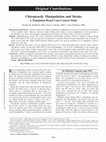
Background and Purpose—Several reports have linked chiropractic manipulation of the neck to disse... more Background and Purpose—Several reports have linked chiropractic manipulation of the neck to dissection or occlusion of the vertebral artery. However, previous studies linking such strokes to neck manipulation consist primarily of uncontrolled case series. We designed a population-based nested case-control study to test the association. Methods—Hospitalization records were used to identify vertebrobasilar accidents (VBAs) in Ontario, Canada, during 1993–1998. Each of 582 cases was age and sex matched to 4 controls from the Ontario population with no history of stroke at the event date. Public health insurance billing records were used to document use of chiropractic services before the event date. Results—Results for those aged,45 years showed VBA cases to be 5 times more likely than controls to have visited a chiropractor within 1 week of the VBA (95 % CI from bootstrapping, 1.32 to 43.87). Additionally, in the younger age group, cases were 5 times as likely to have had $3 visits wi...
Journal of Pathology Informatics
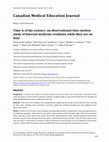
Canadian medical education journal, 2017
The effects of changes to resident physician duty hours need to be measureable. This time-motion ... more The effects of changes to resident physician duty hours need to be measureable. This time-motion study was done to record internal medicine residents' workflow while on duty and to determine the feasibility of capturing detailed data using a mobile electronic tool. Junior and senior residents were shadowed by a single observer during six-hour blocks of time, covering all seven days. Activities were recorded in real-time. Eighty-nine activities grouped into nine categories were determined a priori. A total of 17,714 events were recorded, encompassing 516 hours of observation. Time was apportioned in the following categories: Direct Patient Care (22%), Communication (19%), Personal tasks (15%), Documentation (14%), Education (13%), Indirect care (11%), Transit (6%), Administration (0.6%), and Non-physician tasks (0.4%). Nineteen percent of the education time was spent in self-directed learning activities. Only 9% of the total on duty time was spent in the presence of patients. Six...

The Neurohospitalist, 2017
Background and Purpose: Neurointensive care units have been shown to improve patient outcomes acr... more Background and Purpose: Neurointensive care units have been shown to improve patient outcomes across a variety of neurological and neurosurgical conditions. However, the efficacy of less resource-intensive intermediate-level care units to deliver similar care has not been well studied. The purpose of this study is to evaluate the impact of neurocritical specialist comanagement on patient flow and safety in a neuroscience intermediate-level care unit. Methods: Our intervention consisted of the addition of a physician with critical care experience as well as training in neurology, anesthesiology, or intensive care to a neuroscience intermediate-level care unit to comanage patients alongside neurology and neurosurgery staff during weekday daytime hours. A retrospective analysis was performed on prospectively collected data pertaining to all patients admitted to the unit over a 3-year period, 1 year before our intervention and 2 years after. Patient statistics including wait times to ad...
Gastroenterology, 2007
approved this study. Data Sources Data for this population-based cohort study were obtained from ... more approved this study. Data Sources Data for this population-based cohort study were obtained from 5 sources: the Canadian Institute for Health Information (CIHI), discharge abstract and sameday surgery databases; the Ontario Health Insurance Plan (OHIP) database; the Registered Persons Database (RPDB); the OHIP Corporate Provider Database (CPDB); and the Ontario Cancer Registry (OCR). The CIHI databases contain information about all discharges and procedures done during admission from all acute care facilities and hospital-based same-day surgery units for residents of Ontario since April 1, 1988. All diagnostic codes are recorded according to the Interna

Canadian Association of Radiologists Journal, Jul 1, 2008
Population rates of computed tomography (CT) and magnetic resonance imaging (MRI) continue to inc... more Population rates of computed tomography (CT) and magnetic resonance imaging (MRI) continue to increase markedly. However, little is known about the indications for and results of these imaging tests. A cross-sectional chart-abstraction study was used to determine the indications for and results of outpatient CT and MRI scans performed on or after January 1, 2005, at randomly selected Ontario hospitals. We studied 11,824 CT and 11,867 MRI scans. Cancer-related indications accounted for over 50% of CT scans of the abdomen-pelvis and chest. Headache was the most frequent indication for CT of the brain. More than one-half of MRI scans of the extremities were for knee pain or suspected meniscal tear. Back pain and radiculopathy were the most frequent indications for MRI of the spine. There was considerable variation between institutions in ordering patterns, with as much as a 70-fold difference between hospitals in the frequency of scans ordered for a specific indication. Less than 2% of CT scans of the brain for headache found abnormalities that could explain the headache, while over 90% of MRI scans of the spine for back pain were abnormal, although the clinical importance of the abnormalities was unclear. These data are a starting point for a discussion about appropriateness. Further information will be obtained by examining individual indications more closely, and linking these data to administrative databases to evaluate the impact of these imaging tests on clinical practice.
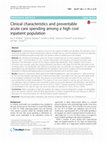
BMC Health Services Research, 2016
Background: A small proportion of patients account for the majority of health care spending. The ... more Background: A small proportion of patients account for the majority of health care spending. The objectives of this study were to explore the clinical characteristics, patterns of health care use, and the proportion of acute care spending deemed potentially preventable among high cost inpatients within a Canadian acute-care hospital. Methods: We identified all individuals within the Ottawa Hospital with one or more inpatient hospitalization between April 1, 2010 and March 31, 2011. Clinical characteristics and frequency of hospital encounters were captured in the information systems of the Ottawa Hospital Data Warehouse. Direct inpatient costs for each encounter were summed using case costing information and those in the upper first and fifth percentiles of the cumulative direct cost distribution were defined as extremely high cost and high cost respectively. We quantified preventable acute care spending as hospitalizations for ambulatory care sensitive conditions (ACSC) and spending attributable to difficulty discharging patients as measured by alternate level of care (ALC) status. Results: During the study period, 36,892 patients had 44,066 hospitalizations. High cost patients (n = 1,844) accounted for 38 % of total inpatient spending ($122 million) and were older, more likely to be male, and had higher levels of co-morbidity compared to non-high cost patients. In over half of the high cost cohort (54 %), costs were accumulated from a single hospitalization. The majority of costs were related to nursing care and intensive care unit spending. High cost patients were more likely to have an encounter deemed to be ambulatory care sensitive compared to non-high cost inpatients (6.0 versus 2.8 %, p < 0.001). A greater proportion of inpatient spending was attributable to ALC days for high cost versus non-high cost patients (9.1 versus 4.9 %, p < 0.001). Conclusions: Within a population of high cost inpatients, the majority of costs are attributed to a single, non-preventable, acute care episode. However, there are likely opportunities to improve hospital efficiency by focusing on different approaches to community based care directed towards specific populations.

Canadian Association of Radiologists Journal, Nov 1, 2006
The first small rural hospital in Ontario to propose a computed tomography (CT) scanner was in Wa... more The first small rural hospital in Ontario to propose a computed tomography (CT) scanner was in Walkerton, a town 160 km north of London. The Ontario Ministry of Health approved the proposal as a pilot project to evaluate the effect on local health care of a rural scanner. This evaluation study had 3 parts: a survey of physicians, a survey of patients, and an analysis of population CT scanning rates. The physicians in the area served by the scanner were asked about its impact on their care of their patients in a mailed questionnaire and in semistructured interviews. Scanner outpatients were given a questionnaire in which they rated the importance of its advantages. The analysis of scanning rates--the ratio of number of scans to estimated population--compared rates in the area with other Ontario rates before and after the scanner was introduced. The physicians reported that local CT allowed them to diagnose and treat patients sooner, closer to home, and with greater confidence. On average, 75% of the patients ranked faster and closer access as very important. Scanning rates in the area rose, although they did not match urban rates. The study confirms that the rural scanner changed the area&amp;amp;amp;amp;amp;amp;amp;amp;amp;amp;amp;amp;amp;amp;amp;amp;amp;amp;amp;amp;amp;amp;amp;amp;amp;amp;amp;amp;amp;amp;amp;amp;amp;amp;amp;amp;amp;amp;amp;amp;amp;amp;amp;amp;amp;amp;amp;amp;amp;amp;#39;s health care in significant ways and that it helped to narrow the gap between rural and urban service levels. We recommend that CT be expanded to other rural regions.

Uploads
Papers by Deanna Rothwell